Value Selling is a sales methodology that prioritizes quantifying and communicating the value of products and services to buyers over product features and capabilities.
Sellers who adopt a value selling approach avoid pitching products. They instead focus their sales efforts on uncovering and dissecting buyer challenges and communicating how their products or services can help solve them.
(Looking for more? Check out Value Enablement: What is Value Selling?.)
Why Value Selling is a Necessity in 2021
B2B buying has changed. According to Gartner’s 2021 Future of Sales research:
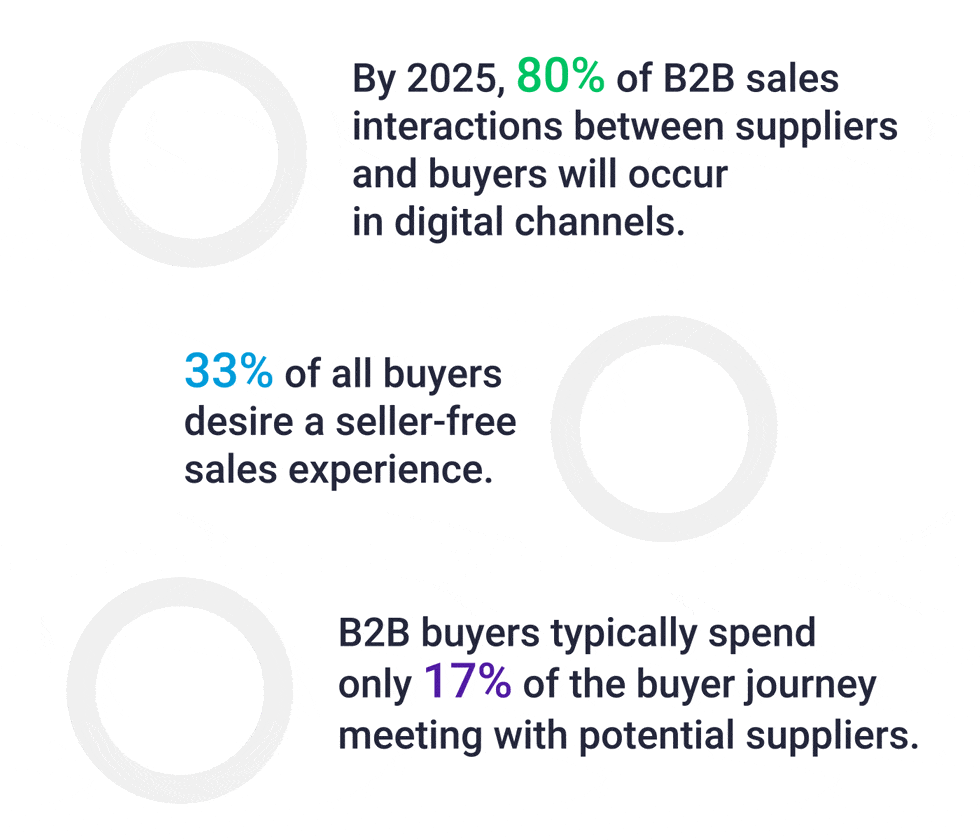
- By 2025, 80% of B2B sales interactions between suppliers and buyers will occur in digital channels.
- 33% of all buyers desire a seller-free sales experience.
- B2B buyers typically spend only 17% of the buyer journey meeting with potential suppliers.
As buyers increasingly rely on digital content and channels to educate themselves about available products and services, it becomes more important to effectively communicate your value proposition at every touch point across the buyer journey – from the first interaction on your website to live sales meetings and post-sale.
“Sales reps will need to embrace new tools and channels, as well as a new manner of engaging customers, matching their sales activity to their customers’ buying practices and information collecting needs,” said Cristina Gomez, managing vice president for the Gartner Sales Practice.
The same is true for marketing and customer success teams. A value selling solution can be leveraged to ensure all of your revenue teams can clearly and consistently communicate your value proposition to differentiate your company and products across the entire buyer journey.
But before you select a value selling solution, there are a few things you need to consider. In this article, we’ll outline:
Why Spreadsheets Are Not an Effective Value Selling Solution
Types of Value Selling Tools and Who Should Leverage Them
How to Ensure the Fastest Time to Value
Considerations for the Best User Experience
How to (Accurately) Measure the Success of Your Value Selling Program
Why Spreadsheets Are Not an Effective Value Selling Solution
If you’re thinking about using Google Sheets or Microsoft Excel to develop spreadsheet-based ROI and TCO tools, think again. While spreadsheets may meet the need to help deliver formal business case justification to financially-focused buyers, they are not the ideal value selling solution. Here’s why:
Spreadsheets Cost Too Much to Develop and Maintain
Spreadsheets typically require the creation of macros and Visual Basic programming to make them easier for sales reps, channel partners, and customers to use.
Beyond usability, getting spreadsheets to support Word or PowerPoint output reports is also a challenge.
If your subject matter expert is programming, they aren’t in the field helping sales reps win deals. Spreadsheet maintenance is also difficult to pass on to other resources, creating a whole new set of challenges if your SME leaves your organization.
Spreadsheets Aren’t Widely Adopted
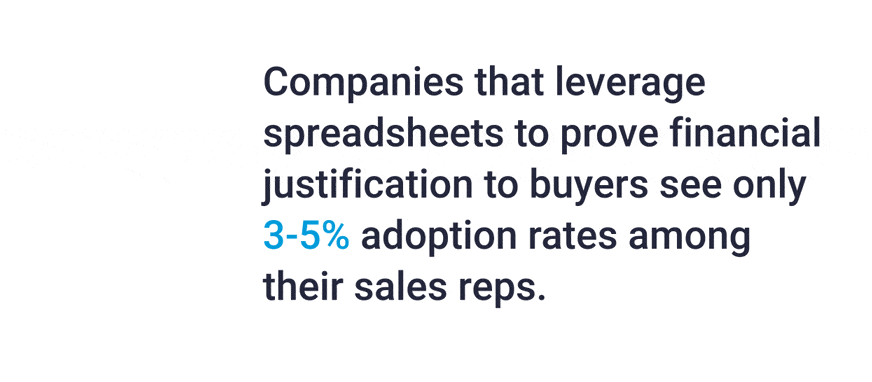
I don’t want to be the bearer of bad news, but on average, companies that leverage spreadsheets to prove financial justification to buyers see only 3-5% adoption rates among their sales reps. Why?
Big, complicated spreadsheets can be intimidating, making sales reps and channel partners less likely to use them.
Spreadsheets Offer Limited Version Control & Security
Controlling distribution and access to ROI and TCO spreadsheets is tricky, making version control and IP protection a challenge.
You can’t be 100% sure customers, sales reps, and channel partners have downloaded the latest version and retired and replaced older versions, making it impossible to keep the field up to date.
And while you can password protect a spreadsheet, it’s too easy for your tool and other important content to fall into the hands of competitors.
Spreadsheets Create a Missed Opportunity for Customer Intelligence
Discovery data captured in value selling tools during sales engagements offers incredible customer intelligence and insights – if you can collect it.
Unfortunately, spreadsheet-based tools can’t automate the collection of this data the way true value selling tools can.
Spreadsheets Do Not Integrate with MAP & CRM
To get the greatest value, any marketing or sales tool you add to your tech ecosystem should integrate with existing systems and processes.
Spreadsheet-based ROI and TCO tools do not properly integrate with MAP or CRM systems.
Spreadsheets Don’t Include Usage Reporting
Spreadsheets don’t offer the ability to track usage and understand where and when your sellers are leveraging spreadsheets across the buyer journey.
Spreadsheets Don’t Tell a Great Sales Story
Research indicates that you must not only provide rational reasons for a customer to make a purchase, but also connect emotionally with your buyer to successfully convey why his current issues are serious and why your value is actionable and unique.
That’s a tall order! And spreadsheets don’t exactly lend themselves to emotional selling. They’re heavy on numbers and rational reasons to buy but light on emotion and value-based storytelling.
Spreadsheets Don’t Offer Third-Party Validation
According to IDC, less than 12% of buyers trust financial justification from solution providers without third-party research and validation.
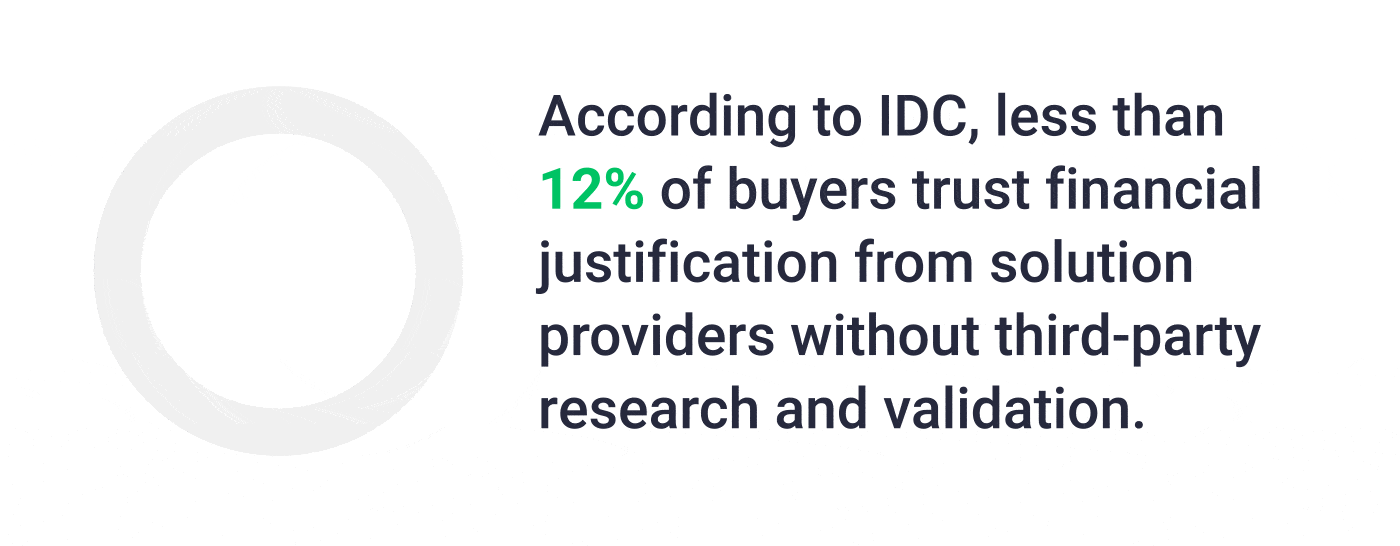
To convince skeptical buyers that your business case is unbiased, you need third-party credibility. Unfortunately, that credibility is not provided by homegrown spreadsheets.
Meanwhile, adopting a true value selling solution like Mediafly ValueStory® can help you:
- Eliminate significant spreadsheet development and maintenance costs
- Drive improved customer, sales rep, and channel partner usage and adoption
- Enhance version control and secure and protect your value-IP
- Collect substantial customer intelligence and actionable insights on usage
- Integrate with MAP and CRM systems for more effective lead capture, nurture and opportunity management
- Combine value messaging and storytelling with financial justification
- Build credibility with third-party validation
(Pssst…We dive even deeper into this topic in Why Spreadsheets Don’t Work. You can download it here.)
Types of Value Selling Tools and Who Should Leverage Them
Now that you understand the value in leveraging a value selling solution over a homegrown, spreadsheet-based tool, let’s dive into the different types of value selling tools and who within your organization should use them.
You’ll want to decide what tool(s) you’d like to develop before selecting a solution provider to be sure they can deliver exactly what you’re looking for. Here are some examples of value selling tools:
Custom Diagnostic Assessments
These self-service marketing tools can be deployed on your website to help prospective buyers answer the question “why change?”
Visitors enter limited profile information, complete a discovery worksheet, and in turn, receive a report containing a capability and maturity framework, relevant use cases, and an improvement roadmap.
The exercise illuminates the customer’s pain points and piques their interest in how your product or service can solve their specific problem.
Self-service assessments also present a unique opportunity for your sales reps to engage customers earlier in the buying process with the intel they need to transform from sales rep to trusted advisor.
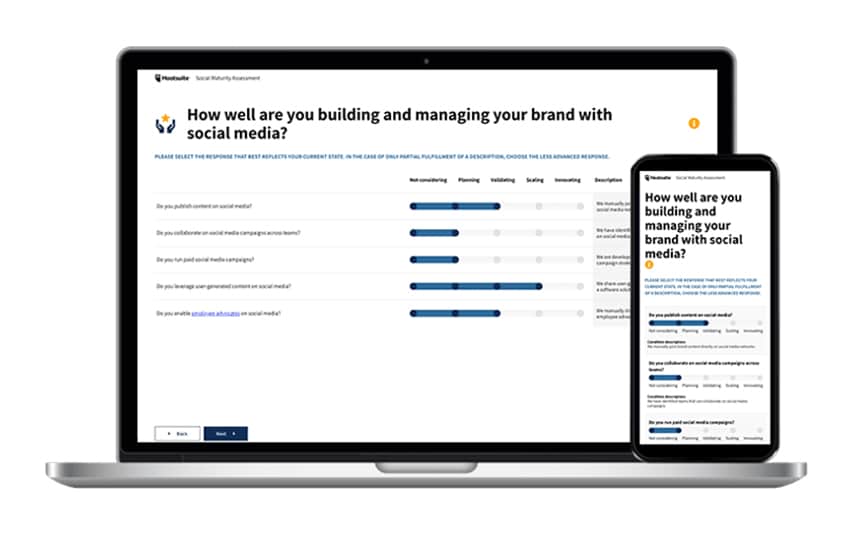
Business Value Tools
Utilized by sellers throughout the exploration and evaluation stages of the buyer’s journey, these sales tools help prospective buyers answer “why now?”
In today’s economy, B2B buyers find it increasingly difficult to justify business purchases. Using business value tools including ROI calculators, your sales reps can quantify what a buyer will gain from the purchase of your product or service.
From an increase in revenue to cost savings, your sellers can use these tools to align proposed solutions to the buyer’s specific business objectives.
When a sales rep can quantify potential savings and business value benefits, and tally the potential return on investment (ROI), it makes it much easier for buyers to take proposals up the chain and gain key stakeholder approval.
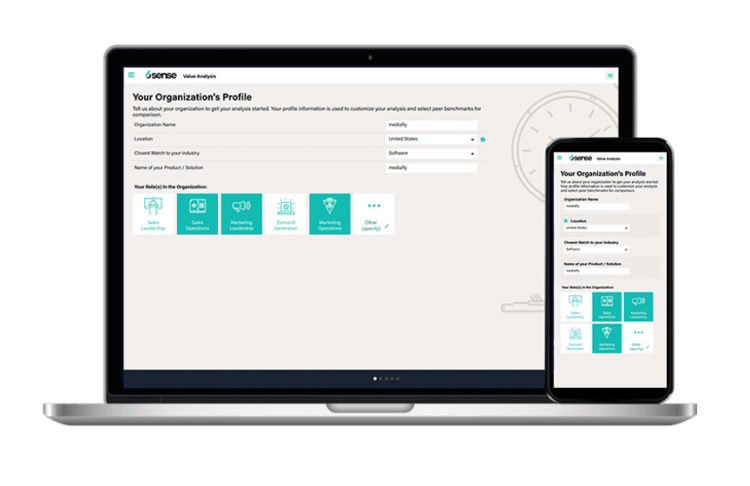
TCO Comparison Tools
In competitive sales scenarios, TCO comparison tools help buyers answer “why you?”
Your sales reps can use TCO tools to show a visual cost-benefit analysis of your product or service side-by-side with your competitor’s offering.
TCO calculators enable your sellers to quantify the total cost of ownership and other advantages of your solution and prove outcomes are achievable with relevant success stories and third-party validation.
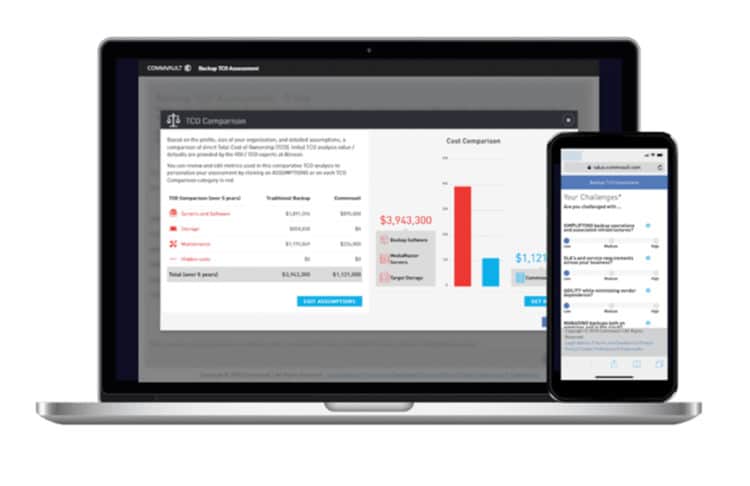
Realized Value Calculators
When leveraged post-sale, realized value calculators help existing customers answer the question “why renew?”
These tools enable customer success and account management teams to prove realized value from using your product or service.
The proof points and projections uncovered by the calculators can also be used to show value in the purchase of additional products or more licenses, increasing upsell and cross selling opportunities.
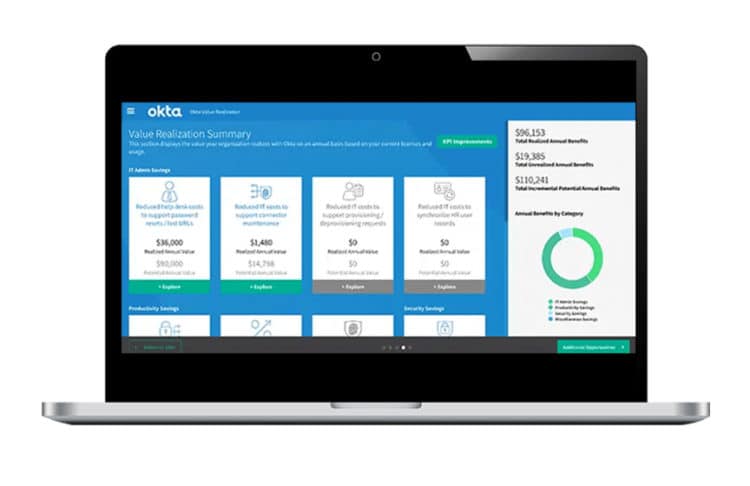
Once you determine the tool(s) you plan to develop, there are a few other things you’ll want to consider before selecting a solution provider.
How to Ensure the Fastest Time to Value
First, you’ll want to understand what the time to value will be – how long will it take to build and launch your tool? How easy will it be for marketers/sellers/customer success managers to onboard and start using the tool?
Custom tools can take a long time to develop. Mediafly streamlines the development process by leveraging content or spreadsheets you’ve already created, integrating with third-party data sources like Nielsen, and hosting collaborative, deep-dive development sessions with new customers.
Our Jumpstart ROI program offers a quick, easy, and risk-free way to get started with value selling tools. The program includes a fully functional and easy to use, interactive value selling tool complete with discovery, storytelling, insights, financial justification and evidence delivered in two weeks or less.
(Want to learn more about Jumpstart ROI? Contact us.)
Considerations for the Best User Experience
Don’t forget about the user experience. A data-driven approach can be overwhelming for customers if not positioned and delivered effectively. Here are two tips to ensure that doesn’t happen:
- Weave the data output into your sales story. Remember, you need both rational and emotional components to create a successful value story. Adopt the CLOSE conversation framework to ensure your data is presented to buyers in a way that’s easy to understand. A sales story that follows CLOSE looks like this:
Challenge: Explain what your buyer is up against. What challenges did you uncover during your initial discovery?
Loss: Paint a picture of what happens if they don’t address the challenge. What is inaction costing your customer every day?
Opportunity: Now describe what happens if they do address the challenge. What will they gain from fixing the problem?
Solution: It’s finally time to introduce your product or service. How can your solution address their specific challenge?
Evidence: Prove it out. Have others in similar situations achieved success with your products or services?

2. Visualize the data to make it easier to consume. Ensure the provider you select can create sleek, attractive and easy to use tools. The easier it is for reps to capture buyer information in real-time or for buyers to guide themselves through a self-service calculator on your website, the better the customer experience will be.
Remember, data can be intimidating. Ensure the report output from your tool is easy to read and understand. Your buyer will use this to make a business case for or “sell” your solution to other key stakeholders internally.
At Mediafly, we deliver our value selling tools via our sales enablement platform, so you can create and deliver relevant content like case studies alongside your custom business value analysis reports for a streamlined user experience.
Mediafly customers can also leverage interactive templates for the reports so your buyers can either share or present an engaging business case to their internal buying committees without having to build anything themselves.
And because it’s delivered via Mediafly, your seller can access advanced analytics including who the report was shared with, what content was viewed, for how long and how many times, so they can identify new decision makers and determine the most appropriate follow-up action.
How to (Accurately) Measure the Success of Your Value Selling Program
Lastly, as you evaluate various providers, ask how their existing customers measure the success of their value enablement programs. To accurately gauge performance, we recommend tracking metrics in three categories: Usage, Scale, and Move the Needle.

Make sure the value selling solution you select has the ability to track and measure the analytics you see here.
Usage metrics like how many users are leveraging the tool or how many reports have been generated are great on their own, but you must be able to tie those metrics to overarching business goals like sales revenue and quota attainment to truly understand how successful your value program is.
Wrapping Up
According to research findings released by ValueSelling Associates earlier this year, 87% of high-growth companies take a value-based approach to sales compared to 45% of negative-growth companies.

To evolve from a traditional sales pitch to a value-based sales story, your revenue teams need proper education, tools, and content.
Ready to get started? Download our Sales Leader’s Guide to Value Selling in 2021.

Comments are closed.